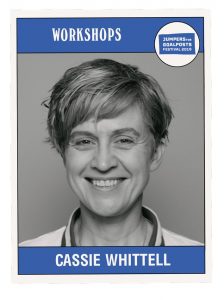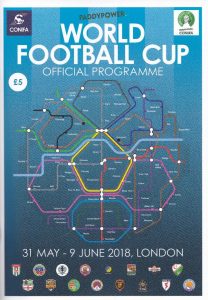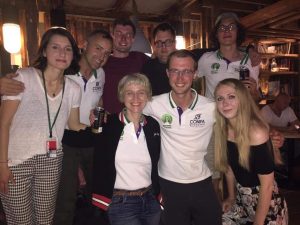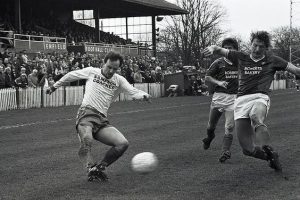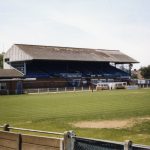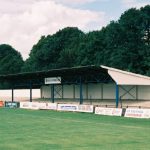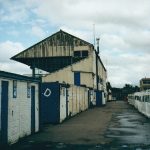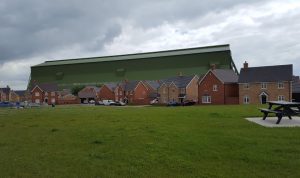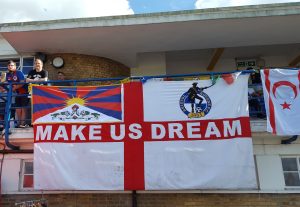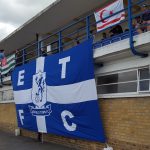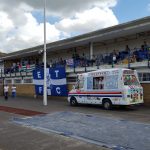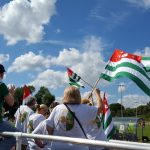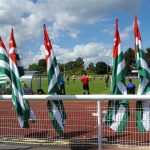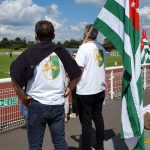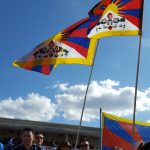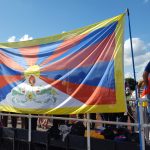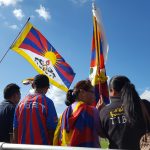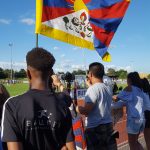Abkhazia 0 Karpatalya 2
Northern Cyprus 3 Tibet 1
Conifa World Football Cup
(at Enfield Town)
Saturday 2 June 2018
The context
I need to thank my friend Cassie for this one, because it was her involvement with the Conifa tournament – as a volunteer, and as programme editor – that encouraged me to think about extending the season by a week, and led Kieran and I to make our second journey to North London in five days. And what a rewarding journey it was. Thanks, Cass!
The history
There are two stories here: the tournament itself, and Enfield Town.
Conifa – the Confederation of Independent Football Associations – is, put simply, the governing body for international football teams who are not FIFA-affiliated. So its members (the word “country” is not used) include small countries (eg Monaco), wholly or partly unrecognised states (eg Northern Cyprus), ethnic groups within a region (eg Karpatalya), and regions spanning countries with a common identity (eg Cascadia). It operates under the strapline “freedom to play football.”

freedom to play football
Conifa was founded in 2013. Its first bi-annual Football World Cup took place a year later, in Sweden, and was won by County of Nice. The 2016 tournament took place in Abkhazia, with the hosts lifting the trophy. Which brings us to London 2018. Under Conifa rules, the tournament does not need to be played in the host’s country, but can take place in the country where the relevant association is based. This year’s hosts were Barawa, whose FA is in London and represents the Somali diaspora in England. So London it was.
Clearly I could write an article just about the tournament, held between 31 May and 9 June at non-League grounds in Greater London. But we will stay with Enfield Town and their own story of exile and homecoming.
Back in the day, or when I started watching football anyway, Enfield FC were big box-office in non-League circles. Had automatic promotion been around in the early 80s they would have been a Football League club: as it was, they won the Conference in 1983 and 1986 and the FA Trophy in 1982 and 1988, but were first denied an election vote due to the shortcomings of their Southbury Road ground, then fell victim to the familiar old pals’ act of the final re-election ballot. Their fans had to watch as long-time rivals Barnet, arguably a smaller and less-distinguished set-up, became established (if transient) League members, while their own side entered a decline that ended in extinction.
- pitch perfect
- a decent ground
- making a stand
I’m not sure what the problem was with Southbury Road, because it always looked a decent enough ground to me. In the end it was sold for development and Enfield began a nomadic existence haunted by boardroom controversy, which continued until they were liquidated in 2007 (a “phoenix” club, Enfield 1893, now play in the Essex Senior League).
By that time Enfield Town had been formed as a breakaway club in protest at the owners, and following an equally peripatetic spell they moved home in 2008 – to the Queen Elizabeth II Stadium, a mere hop across some corporation pitches from the site of Southbury Road, which is now a TGI Fridays.
The journey
Slightly odd routine for Kieran and I today – two games, kicking off at 2 and 5. For all that, we were in London by 12 and I was back in Lancashire before 11. There was even time to nip off the M1 en route to get some pictures of the R101’s old hangars at Cardington, now gradually being swallowed up by housing.
The ground
The Queen Elizabeth II Stadium is that rarest of things, an athletics ground converted for football that manages to serve both sports equally well (and still have some character into the bargain). Half-built for fourteen years because of World War 2, it was completed in 1953 (the QE II designation dates from the Jubilee in 1977, not the more logical coronation).
The Queen Elizabeth’s crowning (sorry) glory is the pavilion. This is a beautiful Grade II listed building in art deco style, and as well as the dressing rooms and bar it also incorporates a roof balcony (in use today as a flag holder) and a small seating tier. There is another, more basic stand behind the track on the far side. More importantly, it has a large open area at the front and this provides that vital feature of any small stadium – a place where people can gather, and socialise, and moan, and offer advice to the manager.
Although in its time the venue’s training facilities had been used by top athletes such as Seb Coe, Daley Thompson and Linford Christie, the arrival of football in 2008 led to a much-needed facelift. Among other things, the track was resurfaced and terracing added, and the ground now is smart and right-sized for the Isthmian League. Town deserve particular credit for an intelligent adaptation. Rather than keep football spectators outside the confines of the track, they have chosen to install terrace covers inside it at each end, with an ingenious system of gates and fences allowing instant conversion for athletics. Football fans can therefore stand right behind the nets, as at a “normal” ground.
- an ingenious system
- art deco style
- roof balcony
- seating tier
- an open area
- gather and socialise
There was a predictably strong groundhopper vibe to the occasion, but this was far from being a purely non-League affair. We met fans of Gillingham, Wycombe and Leeds, along with groups from the West Country, including the Bristol Rovers lads whose flag was a regular throughout the tournament.
Flesh and wine
Non-League fare, and hardly surprising. There was a decent bar upstairs in the pavilion, doing a roaring trade to the extent that the queue sometimes stretched the length of the room and down the spiral staircase. Despite this the (presumably unpaid) staff remained paragons of patience. Foodwise, there was a van. I don’t really do burgers, and two football matches with an hour plus a delayed kick-off between them is a long time. I was hallucinating about pies well before the end of the day.
The games
We instinctively fell into the “wander round the ground while the game’s on” routine that was my habit when I used to write on non-League. This made in-depth analysis difficult as we kept stopping to chat to people, and indeed we were busily engaging with a mixed Exeter-Plymouth group as Gajdos’ deflected shot beat Aleksei Bondarenko in the Abkhazian goal, setting up a Karpatalya victory somewhat against the run of play. Bondarenko’s opposite number, Bela Fejer, had an inspired game. He tipped over a shot from Filatov, and pulled off a Banks v Brazil-type save from Akhulediani’s header. That said, the team from werewolf country hit the woodwork twice and had a further goal disallowed, so Sandor’s late 30-yarder – so outrageously deep into injury time as to be almost in the next match – was a fair reward for their chances on goal.
The small but noisy group of Abkhazian fans were determined to party whatever the score, and party they did. Apparently Abkhazian culture is rich with folk songs and dance, and Abkhazian folk songs are a combination of vocal melody and chanting. We were treated to all these things in the second half as we stood with them on the clubhouse side of the ground. I reckon football is far better when the fans bring their own musical equipment. And chant vocally, obviously.
- small but noisy
- standards
- bearers
The Northern Cyprus v Tibet match was a different kind of affair. The ground’s record attendance rocked up, and the 1200 gate (boosted by North London’s Cypriot community turning up en masse, and smashed out of sight a week later when more than 3000 packed in to see their team play Karpatalya in the final) required a delayed kick off as the two turnstiles struggled to cope.
What Tibet’s fans lacked in numbers they more than made up for in colour and vibrancy. The striking thing about all the supporters here, and also the players, was that they love their cultures in a wholly inclusive style. Tibet, however, took this to another level. There clearly is a way to support your country in a non-jingoistic fashion, and (despite very real political grievances) with quiet dignity, because these people have found it. Hand drums, tonquin horns and flageolets help too.
- colour
- vibrancy
- inclusive
- quiet
- dignity
Their team was widely expected to get tonked, and they feared the worst when Halil Turan burst through and scored with under two minutes gone, closely followed by a mear miss and a disallowed goal from Ugor Gok. Turan also came close towards the interval before Tibet sent their small red and blue pocket of the ground into dancing, singing frenzy with a Kalsang Topygal equaliser from close range. They were very nearly in dreamland soon after the break when he chipped just over the bar, but then the Cypriots took charge and Turan got another from a goalkeeping fumble, before Gok administered the coup de grace with a tasty chip (apologies but I was starving by this point).
Squads and goals
Karpatalya: Csongor, Bidzilia, Peres, Sandor, Molnar, Baksa, Toma, Svedjuk, Szabo, Mile, Frakas, Fejes, Tamas, Vajda, Takacs, Rozman, Illes, Petranics, Barta, Lizak, Szidor, Vago.
Abkhazia: Bondarenko, Akhvlediani, Khagush, Zhanaa, Malaniya, Tsshba, A Khagba, Khugaev, T Khagba, Kogonia, Tarba, Argun, Filitov, Ogbia, Katsuba, Shoniya, Maskaev, Pimpia, Semenov.
Northern Cyprus: Piro, Gench. Onet, Ersalan. Kuri, Kiran, Osman. Turan, Altun, Say, Sadiklar, Erol, Esmeraslan, Sonmez, Oshan, Gacigok, Uysal, Nay, Ucar, Sivri, Kaya, Mercan, Mehmet.
Tibet: Samdup, Tsering, Sangatsang, Bhakdo, Loedup, Wangchuk, Naravan, Chomphel, Dhondup, Sherpa, Thardoe, Topgyal, Phuntsok, Lungkara, T D Bhutia, Tsewang, Ghelek, Tekhang, Tashi, D Bhutia, Yougyal, Choepak, Samphel, Gyatso, Tsering, Tashi.
Goals:
Karpatalya: Gadjos 11, Sandor 97
Northern Cyprus: Turan 1, 66, Gok 74
Tibet: Topgyal 43
